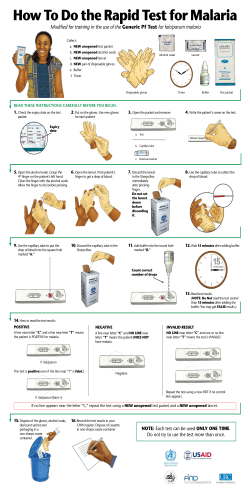
presentation
Malaria Elimination in Mesoamerica and the Hispaniola Island EMMIE Initiative APMEN VII Hoi An, Vietnam 25-27 March 2015 Malaria Elimination in Mesoamerica and the Hispaniola Island EMMIE Initiative APMEN 25-27 March 2015 EMMIE • Arise as a response to the declaration issued in June 2013 during the XX meeting of COMISCA calling for the elimination of indigenous malaria transmission in the region by the year 2020. • The region took the opportunity provided by the GF to submit a concept note to coordinte malaria elimination in it new funding model • Contract was signed in March 2014 Trigger Factors • • • • Political will Steady decline of malaria cases in the region National programmes interest Current development of WHO Global Technical Strategy • Catalytic funding • External partners interested 4 EMMIE Country Members 5 Implementation Mapping Epidemiological Context • In 2013- P. vivax (34%), P. falciparum (65%) and one P. malariae • CQ+PQ first line treatment for Pv and Pf except in Panama that for falciparum use ATM-LUM • No resistance to CQ or PQ have been recently been documented. • No Pf CQR marker have been detected • Vectors An. albimanus, An. vestitipennis, An. pseudopunctipennis and An. darlingi. • Emergence on insecticide resistance to pyrethroid 7 Confirmed Malaria Cases 2002-2014 8 WHERE IS THE PROBLEM? 9 Malaria Strategies Implemented • Scale up of targeted vector control • Improved adherence to treatment • All cases are confirmed by microscopy or RDT and treated according to policy • Presumptive treatment (in areas of difficult access) • QA microscopy • Case investigation Cash on Delivery Courtesy Global Fund to Fight AIDS, Tuberculosis and Malaria 11 Investing for Impact : 70% funds Single impact indicator: number of local malaria cases More solid baseline to be developed in year one (2014): which may lead to increased number of local cases for several countries. Annual target reduction (%) from 2015 onwards: based on a proportional reduction (rather than net numbers) as these will depend on the number of cases reported at the end of 2014. Financial reward liaised to target achievement: at the end of year two (2015) and year three (2016) and for all countries complying with agreed target reduction, with the exception of Mexico. Impact externally and independently verified: rewarding countries post facto when impact has been achieved and confirmed. Investing for Impact : 30% funds Crosscutting strategies: 1. Facilitate a coordinated effort to change focus from control to elimination in existing plans, bilateral agreements, bi-national or transborder work. 2. Accelerate harmonization of key approaches among all countries 3. Build upon existing cross-border work, helping define determinants of country–to-country transmission (migration) in support of more effective operational monitoring. 4. Design of a sub-regional plan to structure civil society participation including the affected populations, in close collaboration with local governments and regional and national partnerships (Above indicative request) EMMIE Grant Distribution Courtesy Global Fund to Fight AIDS, Tuberculosis and Malaria 14 EMMIE Timeframe Courtesy Global Fund to Fight AIDS, Tuberculosis and Malaria 15 16 Baseline and Annual Targets Baseline PAIS 2014 Anual Target Reduction 2015 2016 2017 2018 2019 2020 Belize 19 16 11 8 5 2 0 Costa Rica 6 5 4 2 2 1 0 El Salvador 7 6 4 3 2 1 0 Guatemala 4,931 3,945 2,466 1479* 740 247 0 Haiti 17,494 7,872 4,374 1,749 0 Honduras 3,380 3042 2535 1859* 1014 169 0 Nicaragua 1,163 930 698 465 233 116 0 Panama 874 743 524 350 219 87 0 Dominicana Republic 496 397 298 174 99 50 15,745 12,246 0 17 Achievement Y1 • Start up fund disbursed • Harmonization of diagnosis blood smear staining • Civil Sociaty Leage structured • Verification methodology developed 18 CoD Model: Preliminary Observations form Year 1 1. 2. 3. 4. 5. SUCCESSES YEAR 1* Engaging stake holders Leverage additional investment Development of Global Fund policies and procedures for CoD Data Verification Mobilizing Technical Expertise 1. 2. 3. 4. 5. CHALLEGES YEAR 1* Award based on a single indicator Start-up funding Communication process Sustaining engagement to achieved results Analysis of efficiencies: is CoD a more efficient way of doing business? *Preliminary results Cash upon delivery evaluation CHAI 2014 19
© Copyright 2025





















